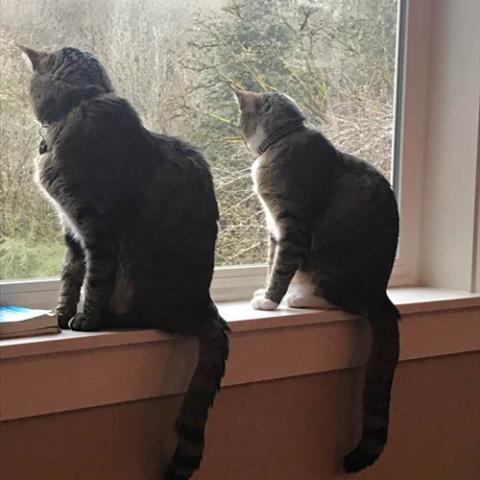Keep Cats Safe at Home By Transitioning From Outdoor to Indoor
Have you considered transitioning your cat indoors but haven’t been able to get started? According to the Humane Society, about two-thirds of cats live indoors either all or almost all of the time. As your vet will support, these indoor felines enjoy freedom from a laundry list of perils - diseases, parasites, automobile traffic, poisoning, our healthy population of urban coyotes, and simply getting lost.
Take the pledge to keep cats safe at home
Of course – the decision to keep your cat inside or out is deeply personal. But perhaps you attended our Catio Tour this fall, or have been following recent reports detailing domestics cats devastating impact on urban wildlife, and have be inspired to try giving your cat a new indoor lease on life. This New Year, consider a resolution that puts the birds in your back yard first.
Why Now?
There’s no better time than winter to get started. Bitter cold winter temperatures and dreary rain present the perfect opportunity to begin the transition. Cats are naturally less interested in being outdoors. This provides an ideal window to make the transition before bird nesting season begins in March. So, here’s some inspiration and suggestions for making fluffy the happiest housecat on the block. Thanks to the Humane Society for many of these great ideas.
Start by creating your kitty’s indoor sanctuary
A luxurious indoor environment, particularly in the winter, may be all your cat needs to become a convert. Introduce items such as a cozy bed in a sunny location, a scratching post, something to climb and view the indoor and outdoor world from above, areas for hiding (such as brown paper bags or cardboard boxes) and new toys for indoor enrichment before you make the transition to indoor living.
Take your time
You’ll have the most success by making the transition gradual until the new way of life becomes second nature. Be prepared for a little lashing out against the new lifestyle - i.e. scratching at doors, claw at windows, yowling, and trying various escape tactics.
- Start with baby steps like always feeding your cat indoors.
- After meals, instead of letting them out immediately, keep them inside for gradually longer periods each day.
- Keep cats indoors during dawn and dusk hours and gradually increase the amount of indoor time around dawn and dusk.
- For the feline escape artist that’s forever bolting toward open doors, train or lure them away from the open door. Run practice trials where you leave the door ajar and squirt them with a water gun or rattle a jar of coins to startle them. Also try luring them the other way by tossing a treat in the opposite direction. The goal is not to punish the cat but to associate the door with something unpleasant.
Make indoor life fun
Cats have been domesticated for thousands of years but they still have wild behaviors deeply encoded in their DNA. Have fun with this by providing varied enrichment that honors your cat’s unique behavior. Ideas include:
- Toys that allow your cat to express instincts such as stalking, chasing and pouncing. Even simple items like a bottle cap can provide endless entertainment.
- An indoor planter containing feline favorites such as catnip and wheat grass for them to chew on (available at pet supply stores)
- Train her to walk on a cat harness and leash and take him for a stroll
- Give her lots of your time and attention. Set aside play time each day.
- Consider building a “catio” – a fully-enclosed outdoor cat-patio - attached to the house where your cat can enjoy an outdoor experience.
More tips to keep cats happy in winter
Ultimately, do your best not to give in to their requests to go out, and distract them with play. As one out of every four common bird species faces serious population declines, help us keep common birds common by decreasing the man-made hazards they face. Even small steps toward keeping your cat indoors can make a positive impact. For additional support and tips, see the Humane Society of the United States website.
Learn more about cats safe at home program

